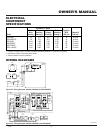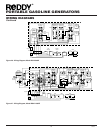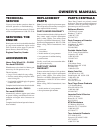
10
104960
PORTABLE GASOLINE GENERATORS
®
Running Starting
Equipment Watts Watts
1/2" Drill 1000 1250
Toaster 1200 1200
Coffee maker 1200 1200
Skillet 1200 1200
14" Chain saw 1200 1500
Water well pump
(1/2 hp) 1000 3000
Hot plate/range
(per burner) 1500 1500
10" Table saw 2000 6000
Water heater
(storage-type)
5000 5000
Running Starting
Equipment Watts Watts
Light bulb (100W) 100 100
Radio 150 150
Fan 200 600
Television 400 400
Furnace fan
(1/3 hp)
with blower 600 1800
Vacuum cleaner 600 750
Sump pump
(1/3 hp)
700 2100
Refrigerator/freezer 800 2400
6" Circular saw 800 1000
Floodlight 1000 1000
ent size motors. For example: an elec-
tric motor nameplate states 5 amps at
120 volts. 5 amps x 120 volts = 600
watts running. Multiply this figure by
3. This will show the starting watts
needed. 600 watts x 3 = 1800 watts to
start. When figuring the generator load
for motors, you must use the starting
watts figure. Do not use the running
watts figure.
Note:
Some motors re-
quire nearly the same wattage to run as
to start. These items include saws,
drills, hair dryers, and food mixers. See
Chart 1 for typical appliance wattage
examples.
4. Add watts and starting watts of all
items. This total must not be larger than
the rated wattage of your generator. It
is a good idea to have up to 25% extra
capacity for future needs or extra
equipment.
Approximate Starting Watts*
Motor Approximate Universal Repulsion Split
HP Running Motors Induction Capacitor Phase
Rating Watts (small appliance) Motors Motors Motors
1/8 275 400 600 850 1200
1/4 400 500 850 1050 1700
1/3 450 600 975 1350 1950
1/2 600 750 1300 1800 2600
3/4 850 1000 1900 2600 x
1 1000 1250 2300 3000 x
1 1/2 1600 1750 3200 4200 x
2 2000 2350 3900 5100 x
3 3000 x 5200 6800 x
Chart 2
* – Always use starting watts, not running watts, when figuring correct electrical load.
x – Motors of higher horsepower are not generally used.
Chart 1 - Typical Electric Appliance Wattages
STANDBY
INSTALLATION TO
HOME OR
BUILDING
WARNING: Have standby in-
stallation performed by a skilled,
licensed electrician. Do not let
anyone else wire into a utility
circuit. Personal injury, equip-
ment damage, or damage to home
could occur.
IMPORTANT:
This generator will not
power your entire home. Most home utility
electric service is more than 60 amps. This
will exceed generator output. Only power
needed items during a power outage. Make
sure total wattage of electrical load does not
exceed rated wattage of generator.
You may need to use this generator as a
standby power source. During a power out-
age, the generator will power selected items
in a building. Have generator and additional
wiring installed by a skilled, licensed elec-
trician. This is not a do-it-yourself job. Fol-
low all local codes.
WARNING: The electrician
must install a double-throw trans-
fer switch. This isolates existing
electrical circuits from the utility
power line. If not isolated, gen-
erator output will back-feed into
utility power line. This may elec-
trocute a power company line
repair person.
DETERMINING
ELECTRICAL LOAD
FOR GENERATOR
You must decide what electrical load your
generator can power. Do this before using
generator. Use the following four-step
method. It will help you select a load that is
not too large. Make sure total wattage of all
electrical loads does not exceed rated watt-
age of generator. For rated wattage of your
generator, see Specifications, page 5. Elec-
tric motors present a special problem when
figuring load. Read Step 3 carefully.
1. Make two lists of items you want pow-
ered by generator. List all motors and
motor powered appliances in one. List
all lights, small appliances, etc. in the
other. For standby service to home or
building, only include items you must
power.
2. Enter running watts of each item ex-
cept motors. The light bulb or appli-
ance nameplate lists its wattage. Re-
member, 1KW = 1000 watts.
Note:
The
nameplate may not list wattage. It may
only list volts and amps. The formula
for finding wattage is: Volts x Amps =
Watts. For example: An appliance
nameplate states 3 amps at 120 volts. 3
amps x 120 volts = 360 watts.
3. Electric motors present a special prob-
lem. They require up to three-times
their rated wattage to start. Chart 2,
below, shows starting watts for differ-


















